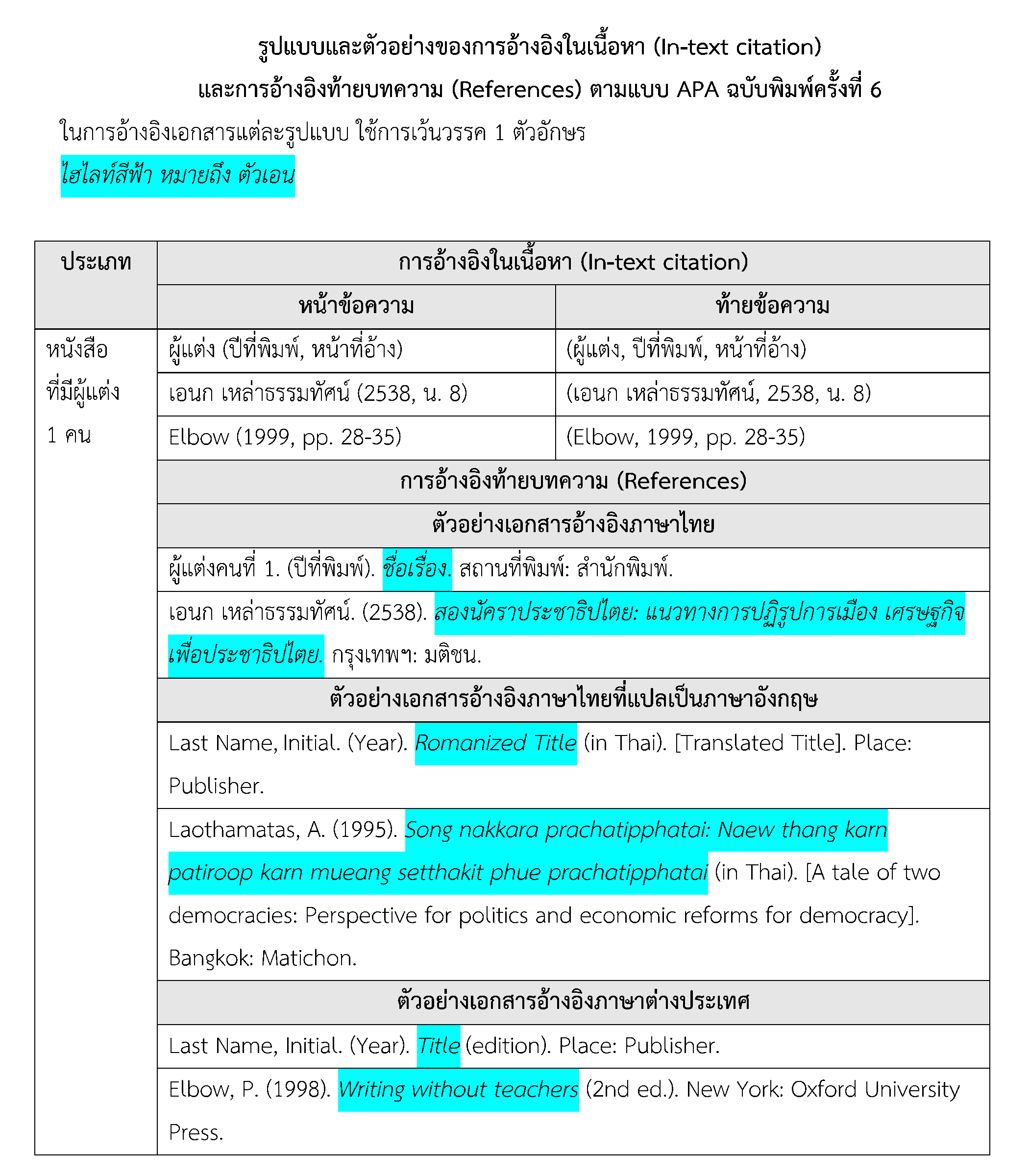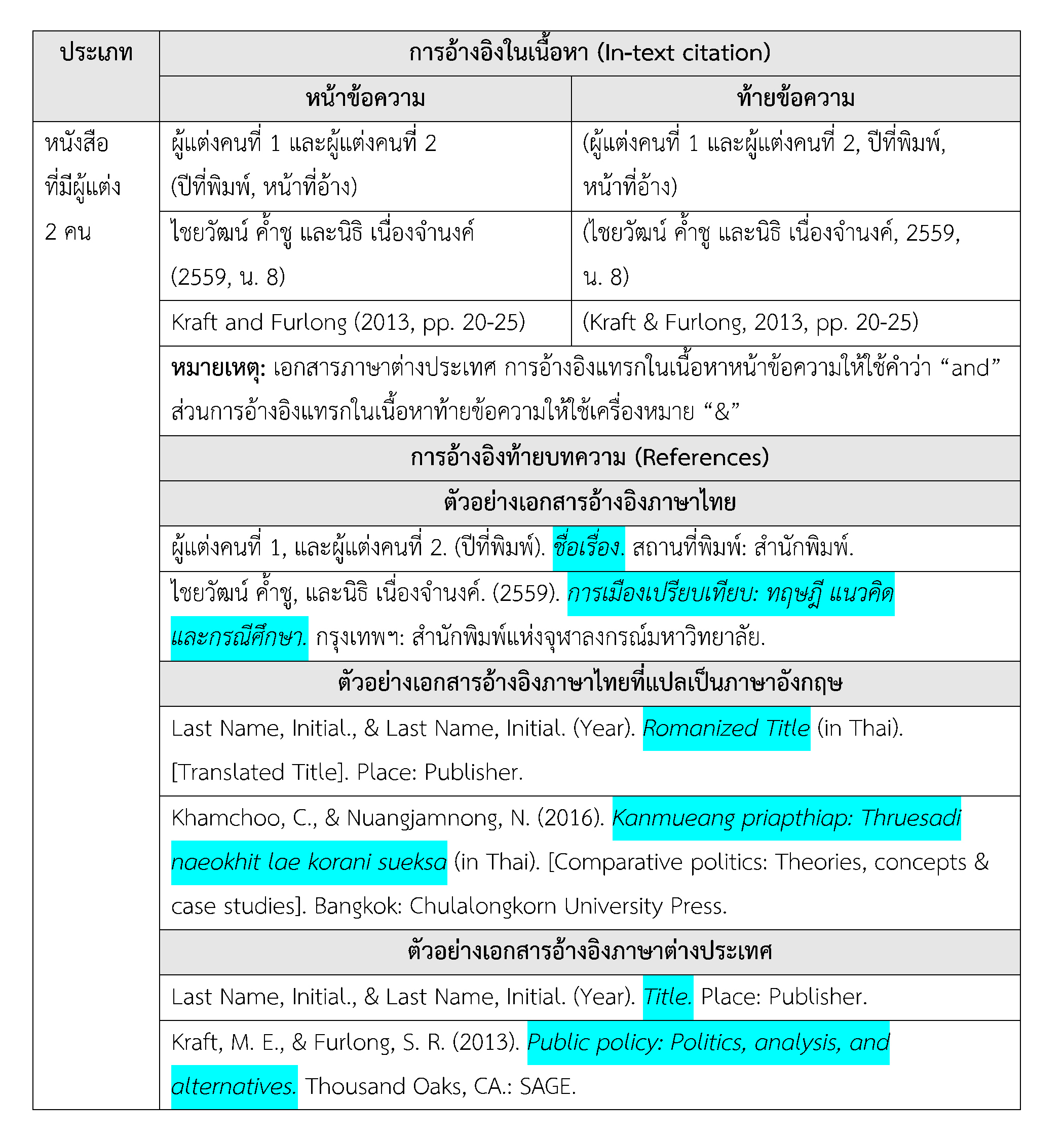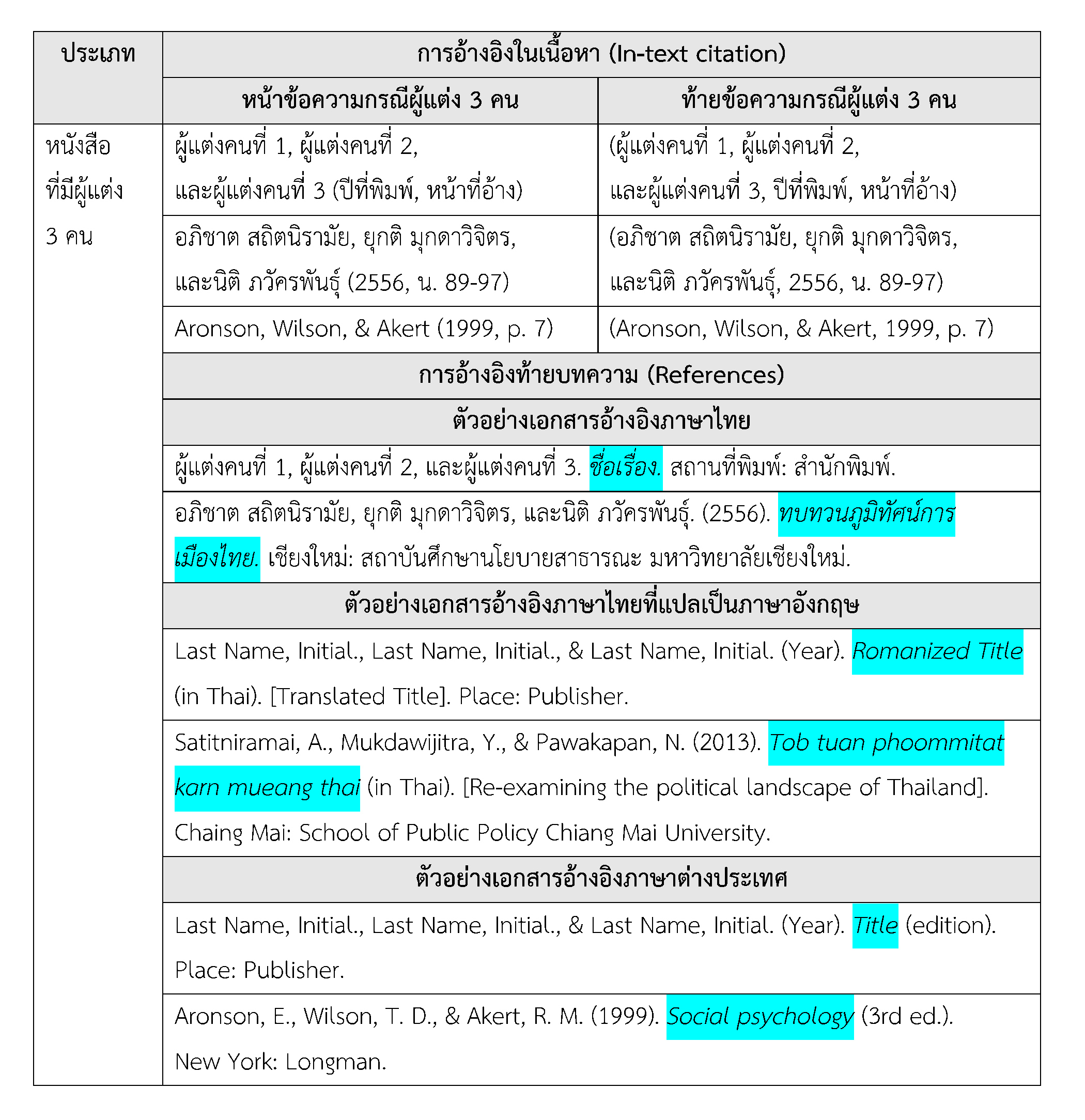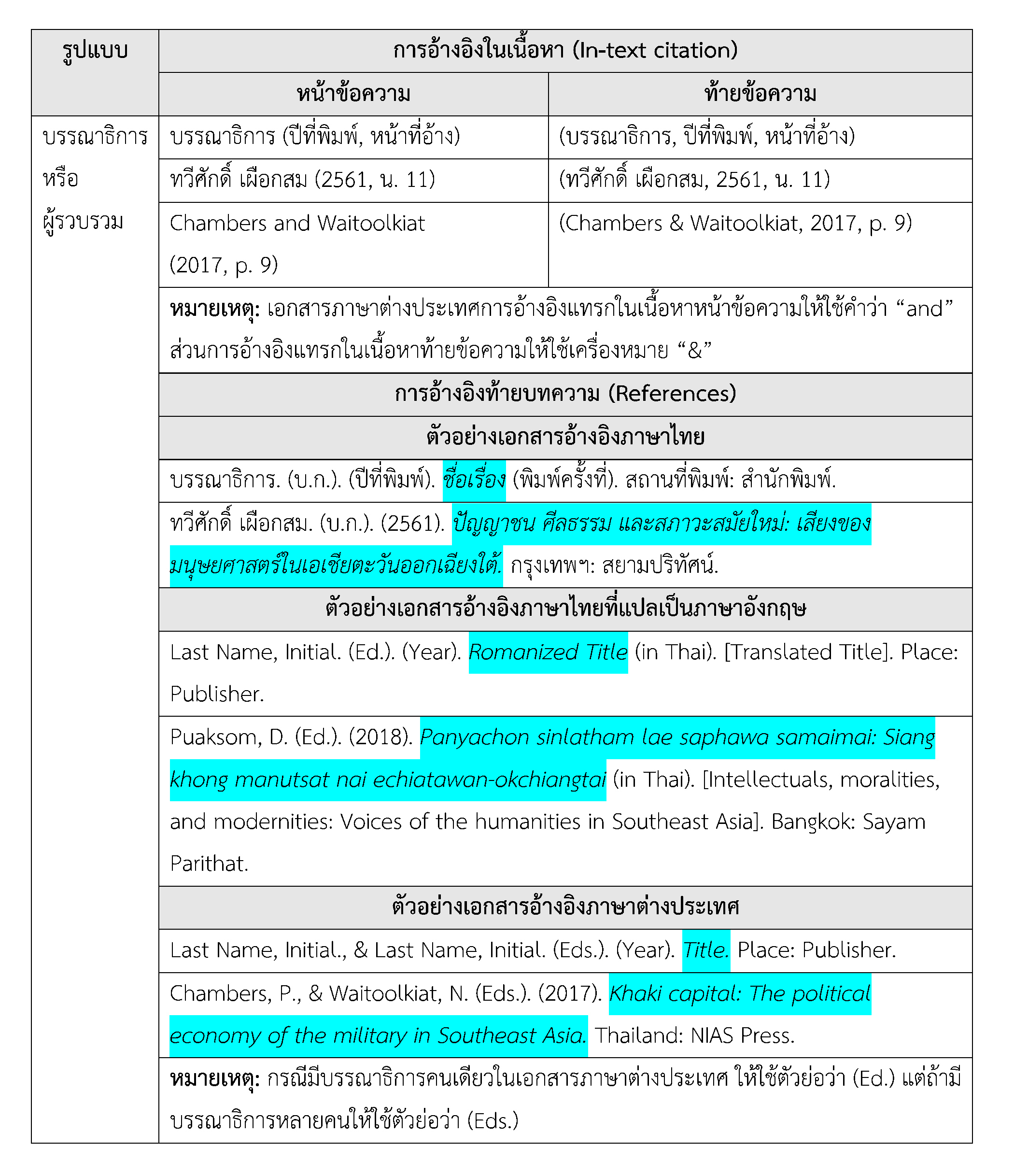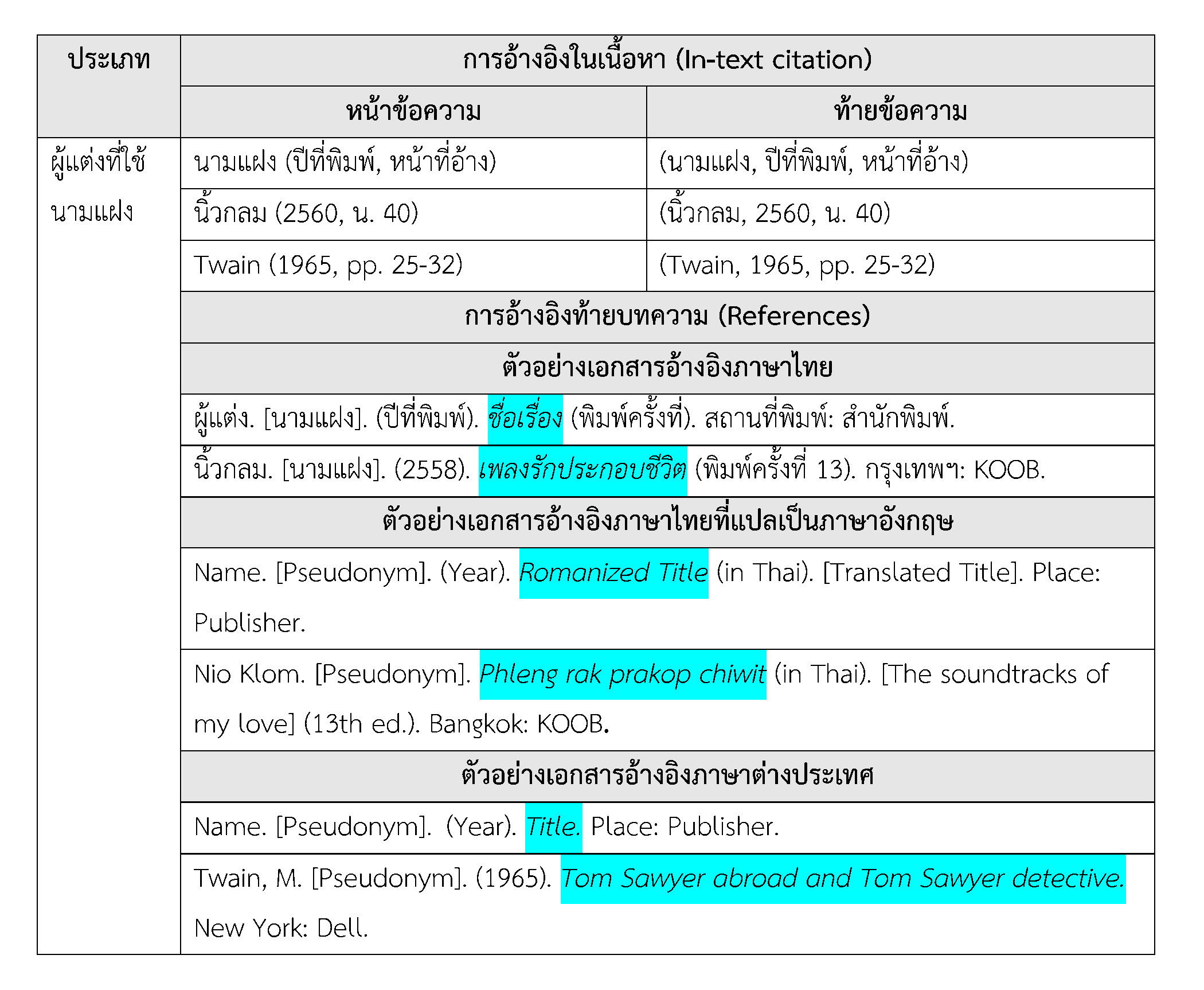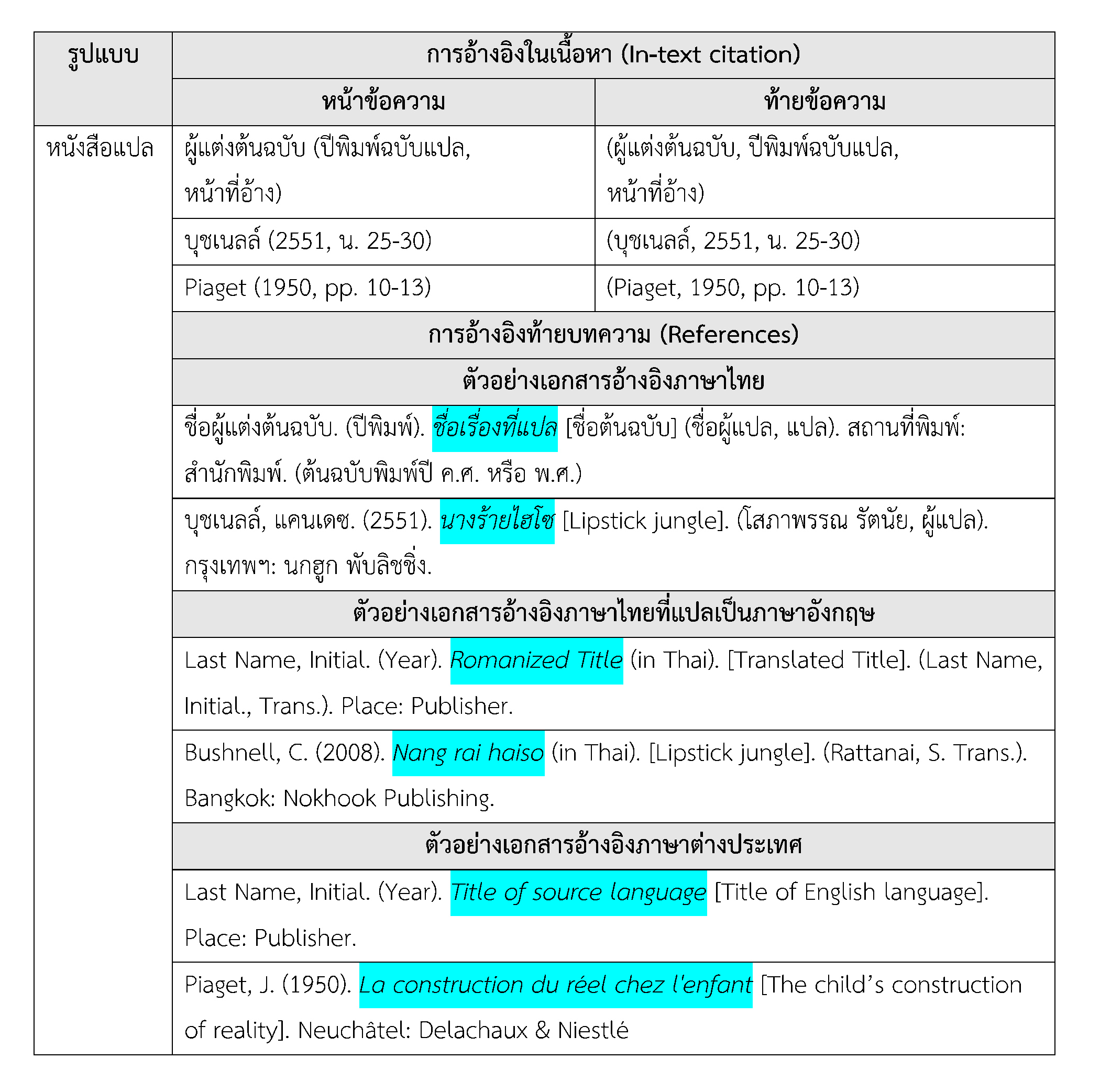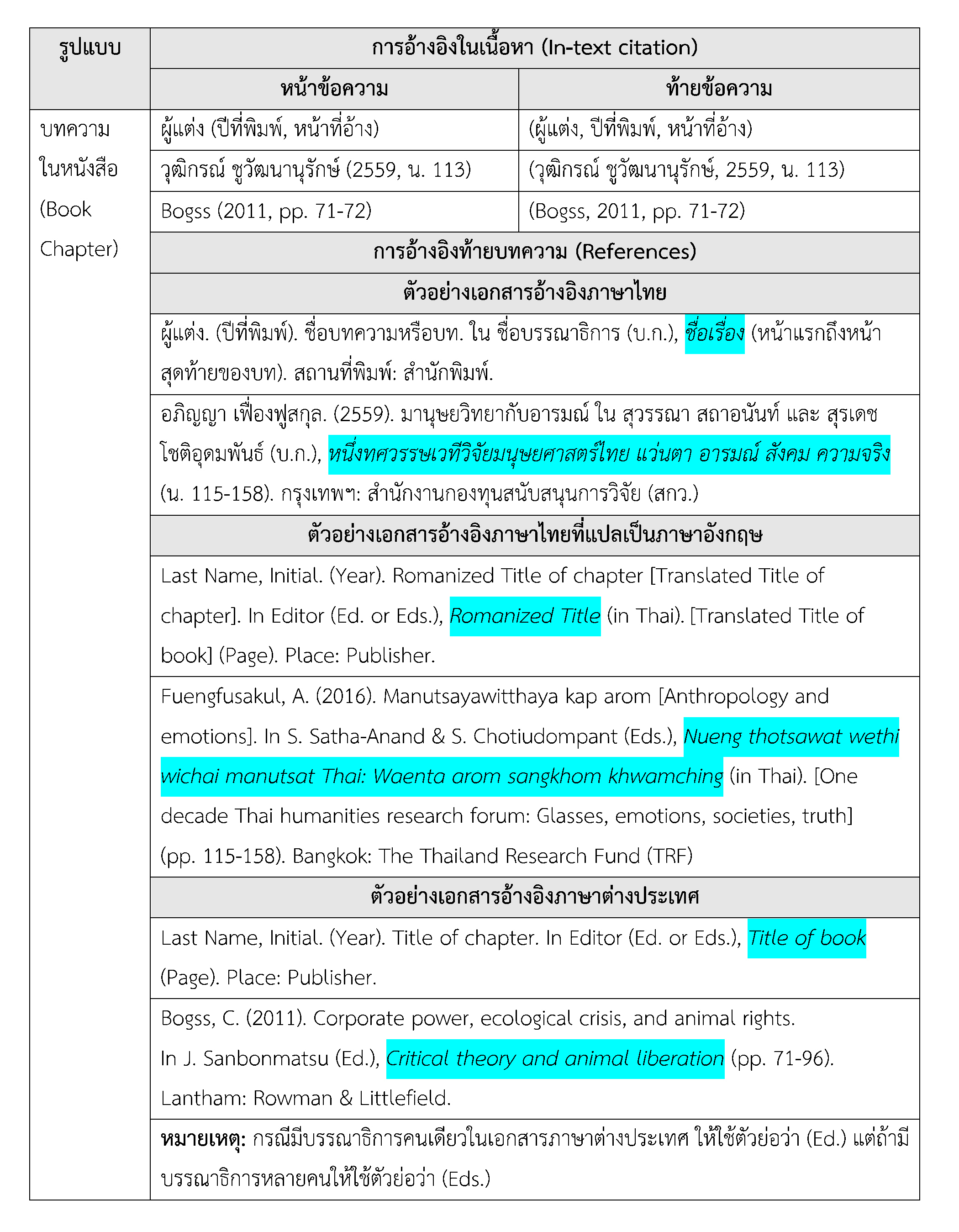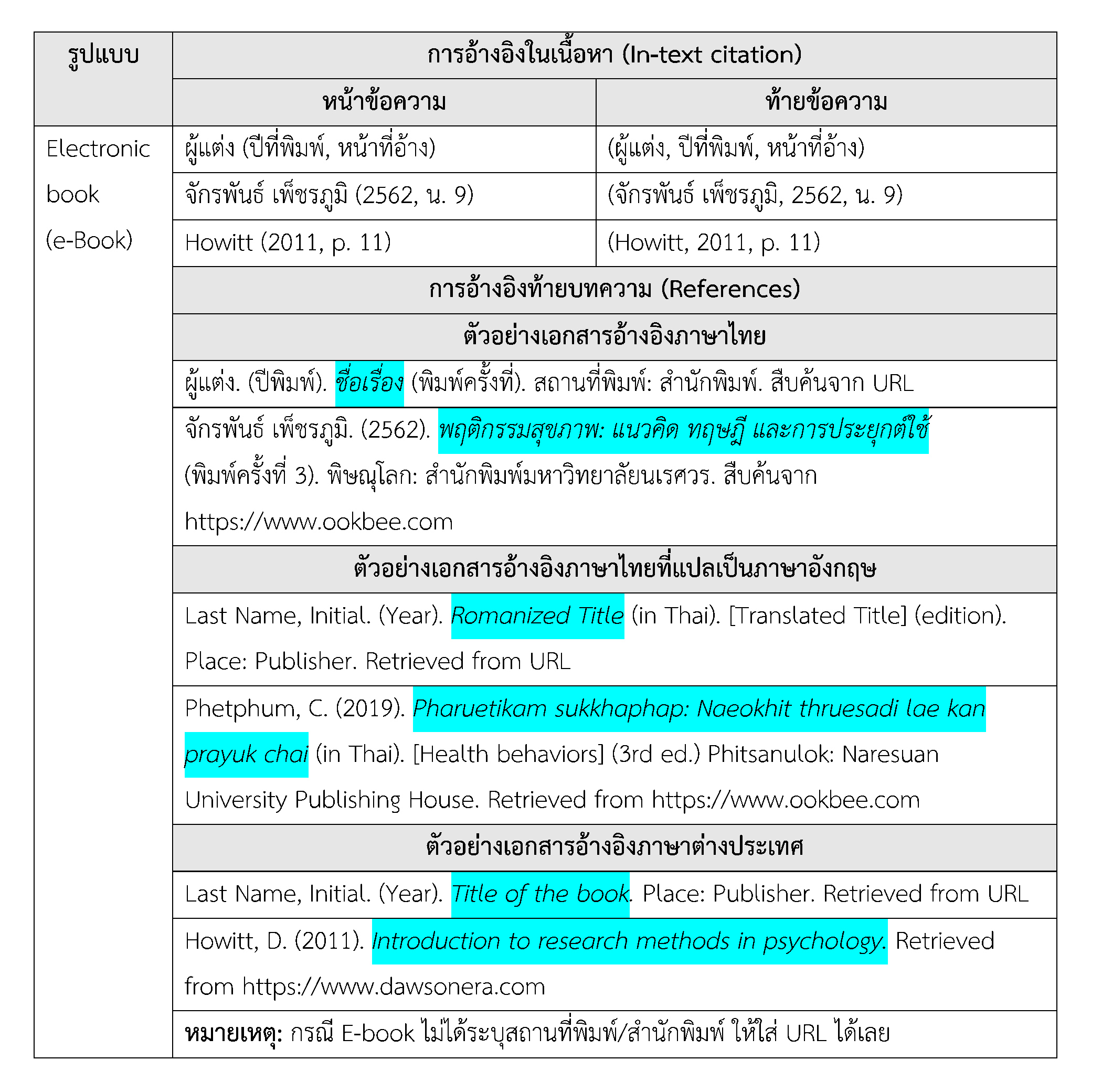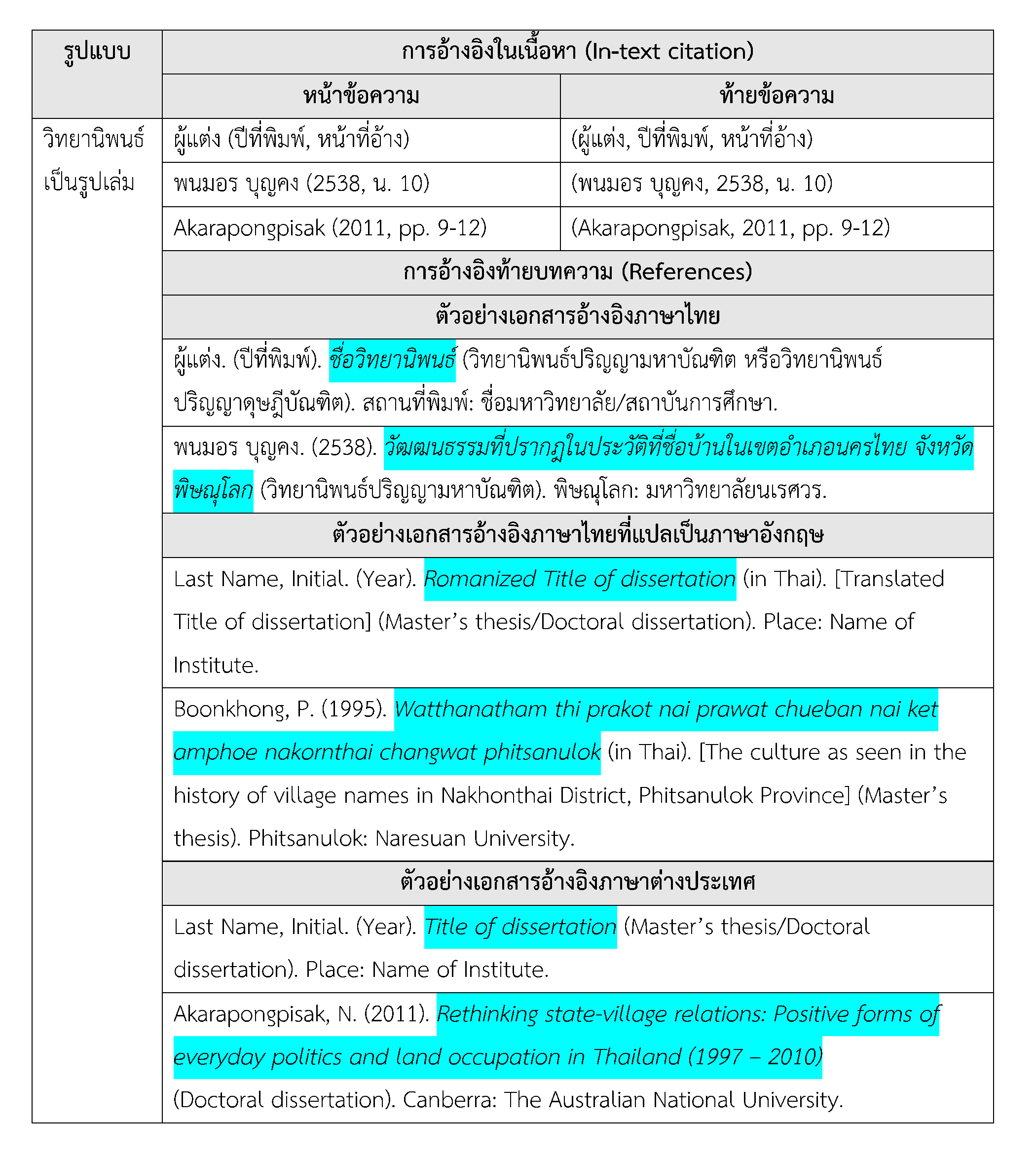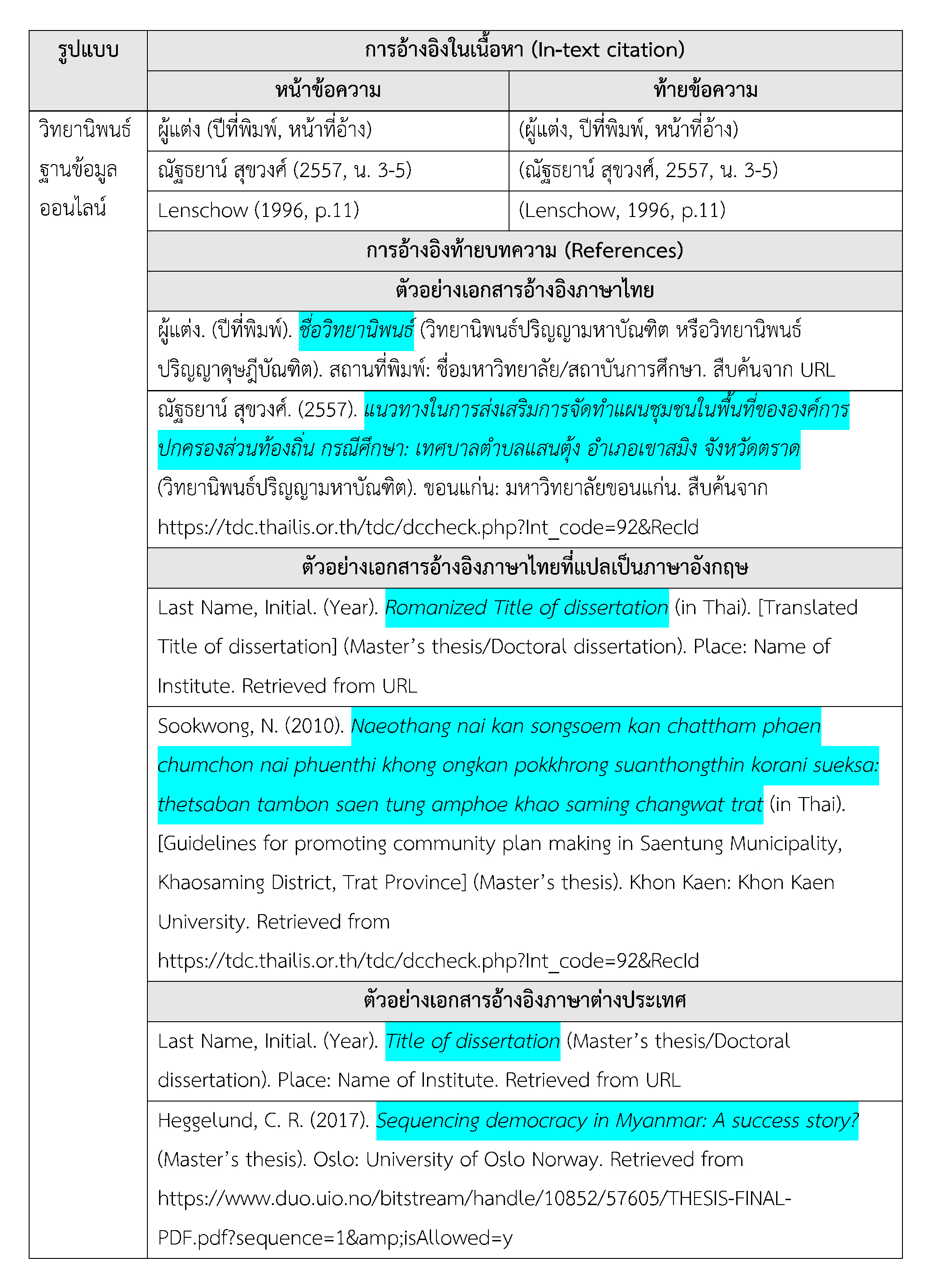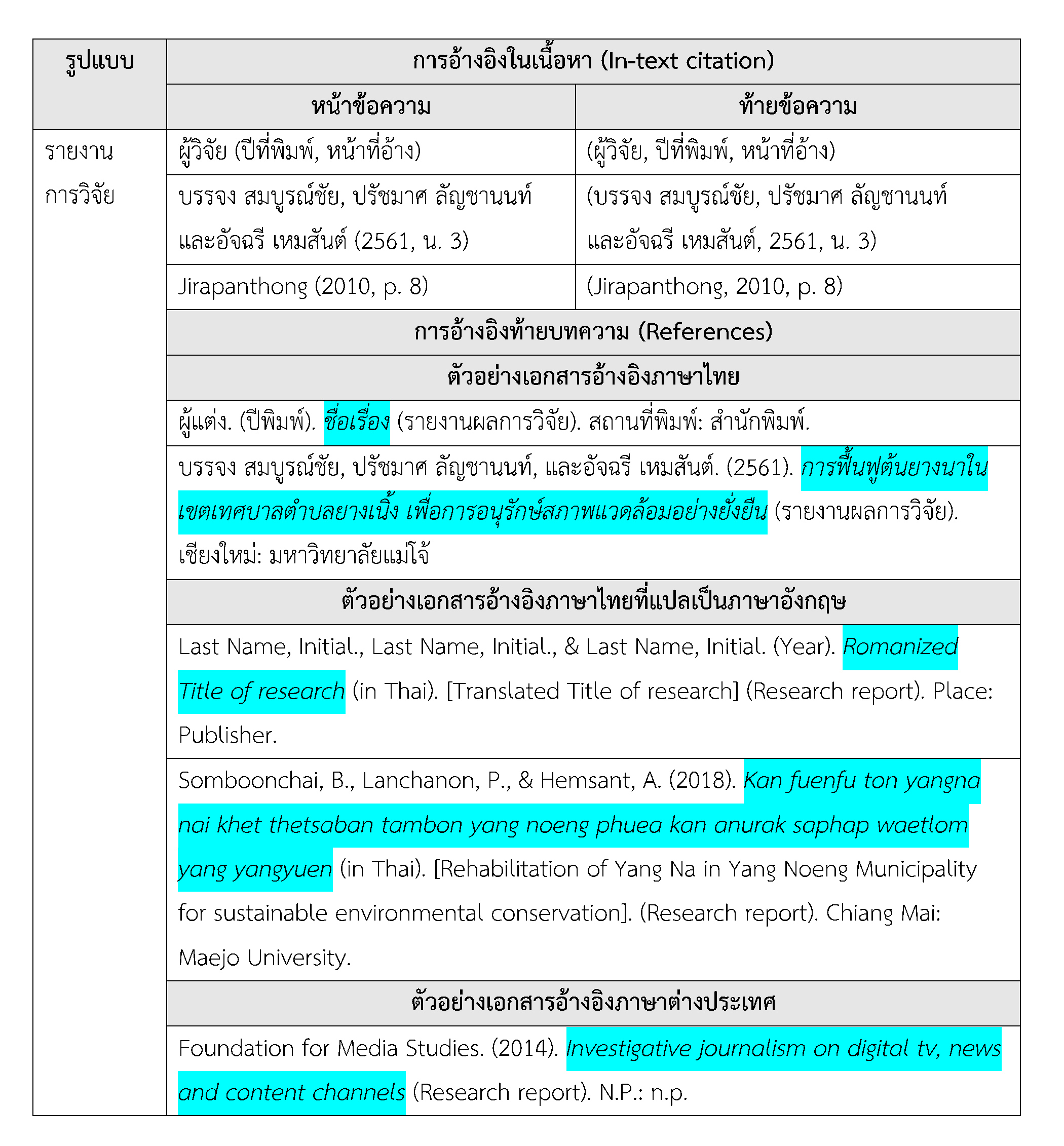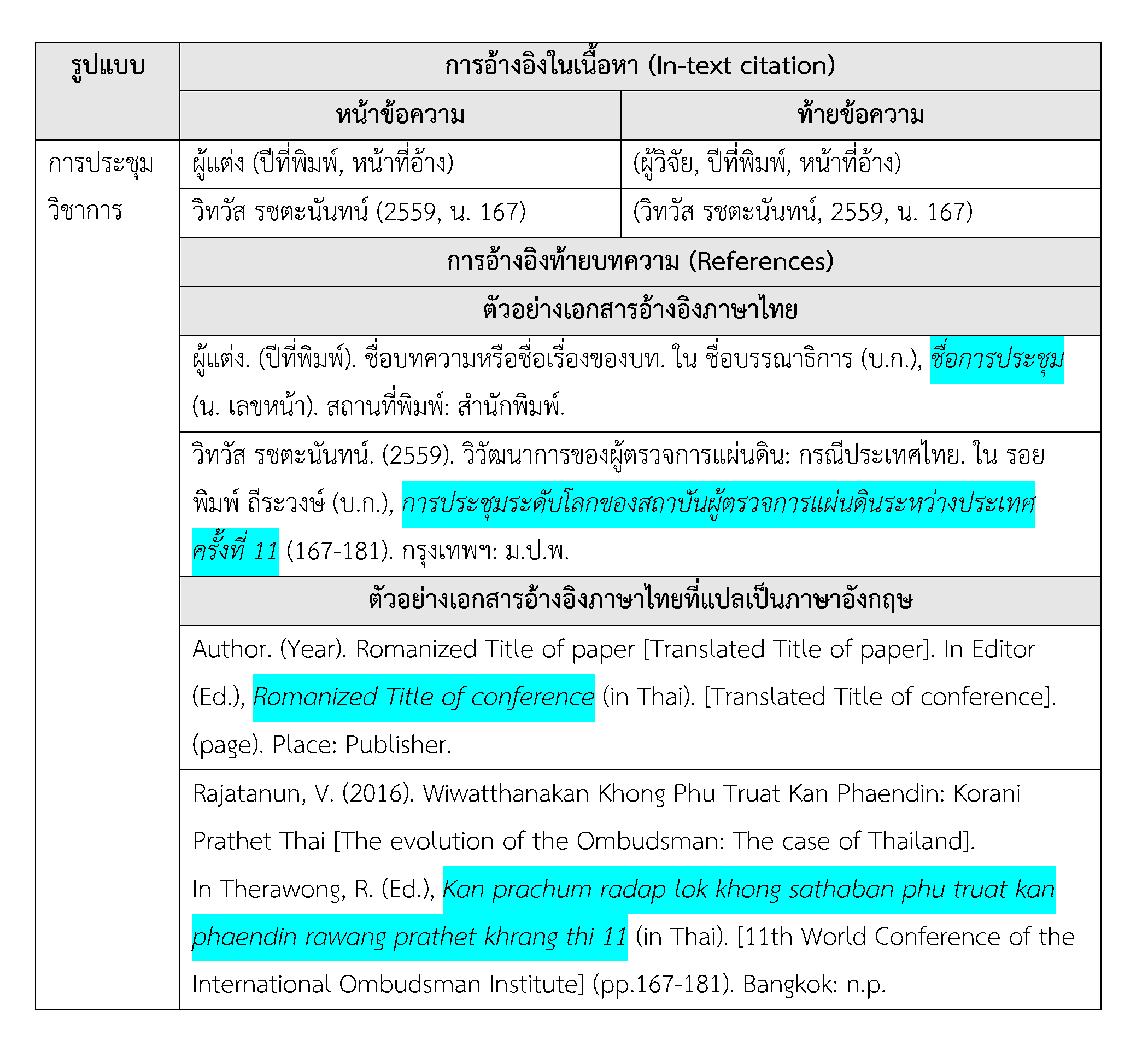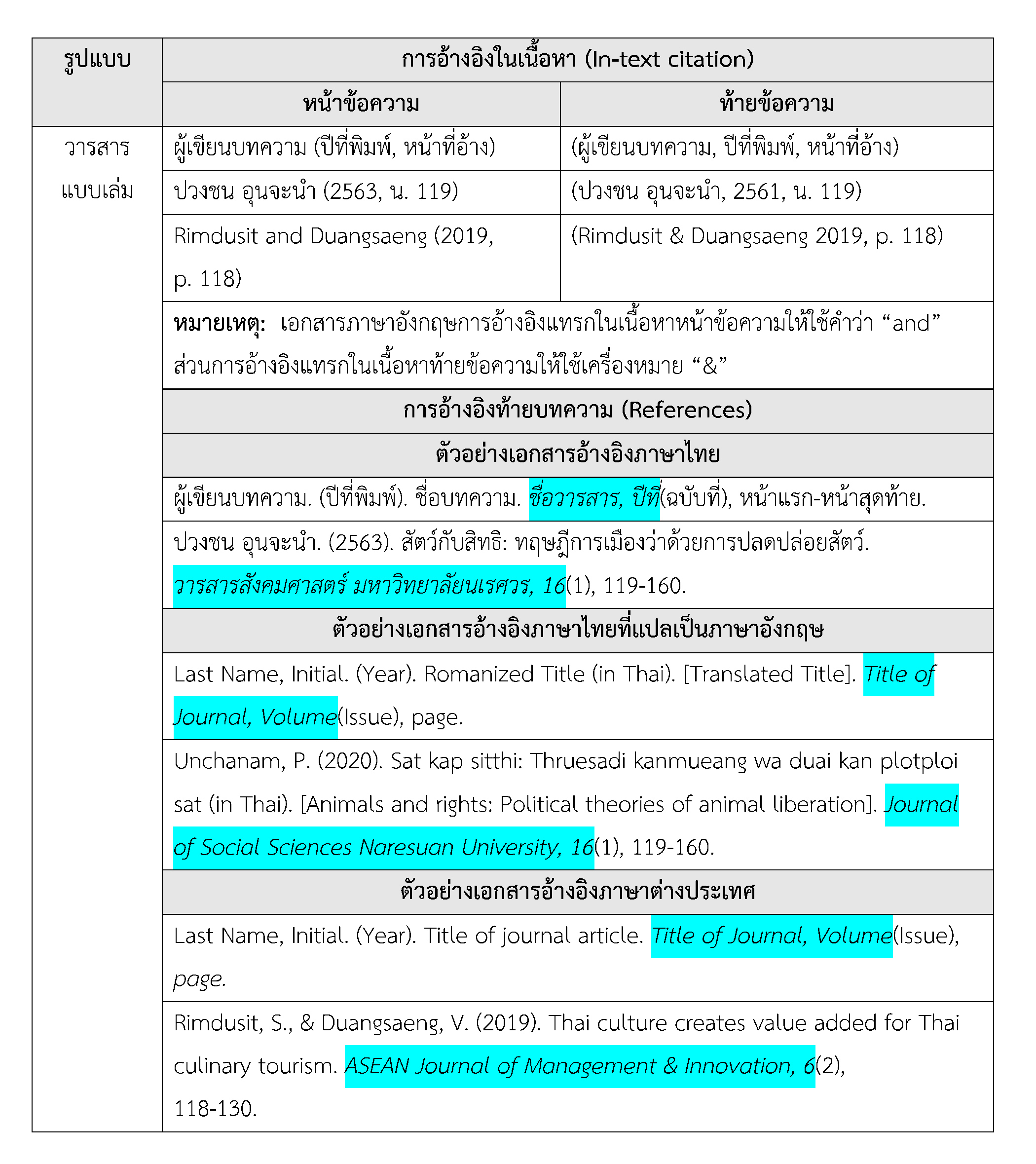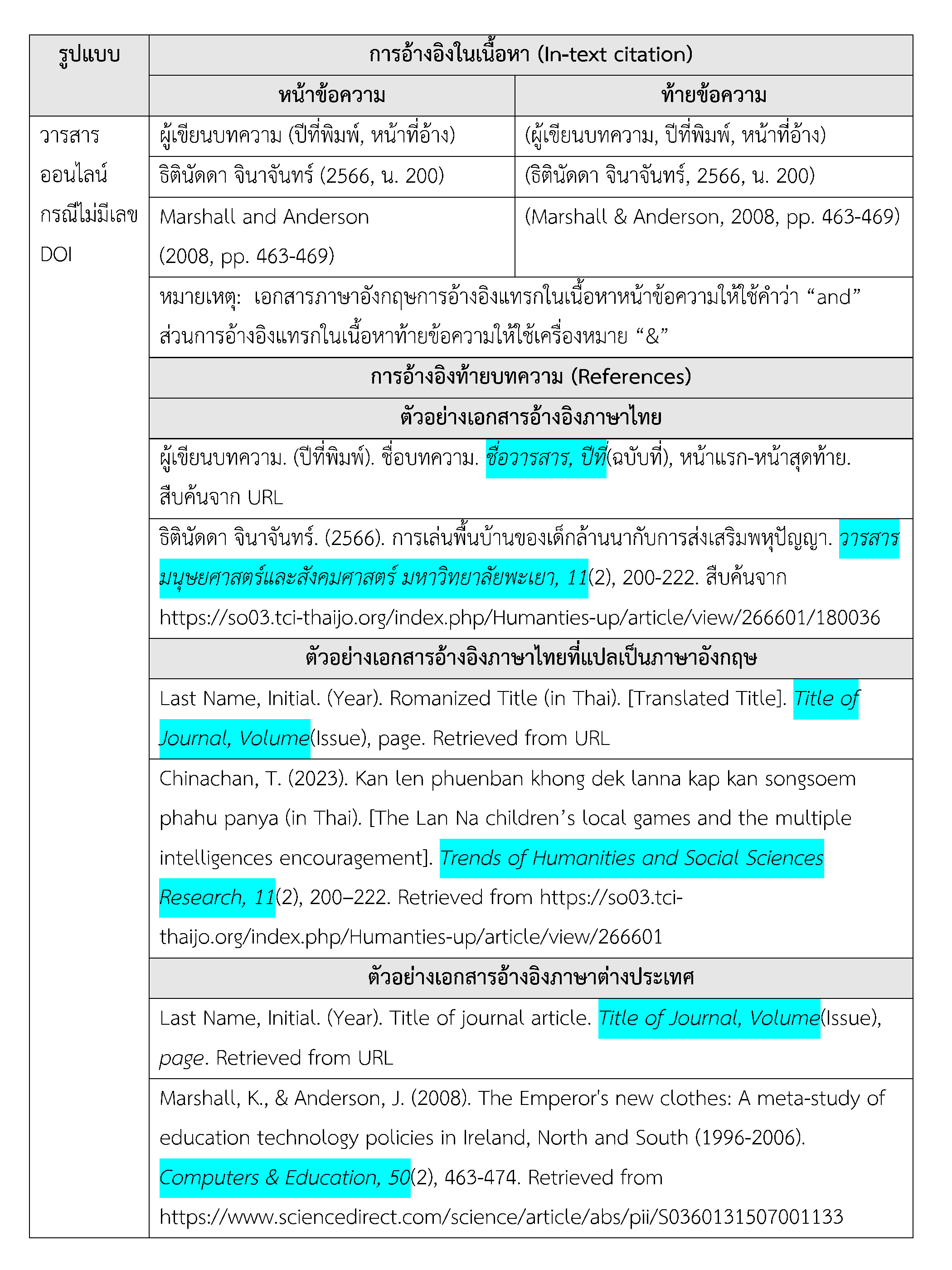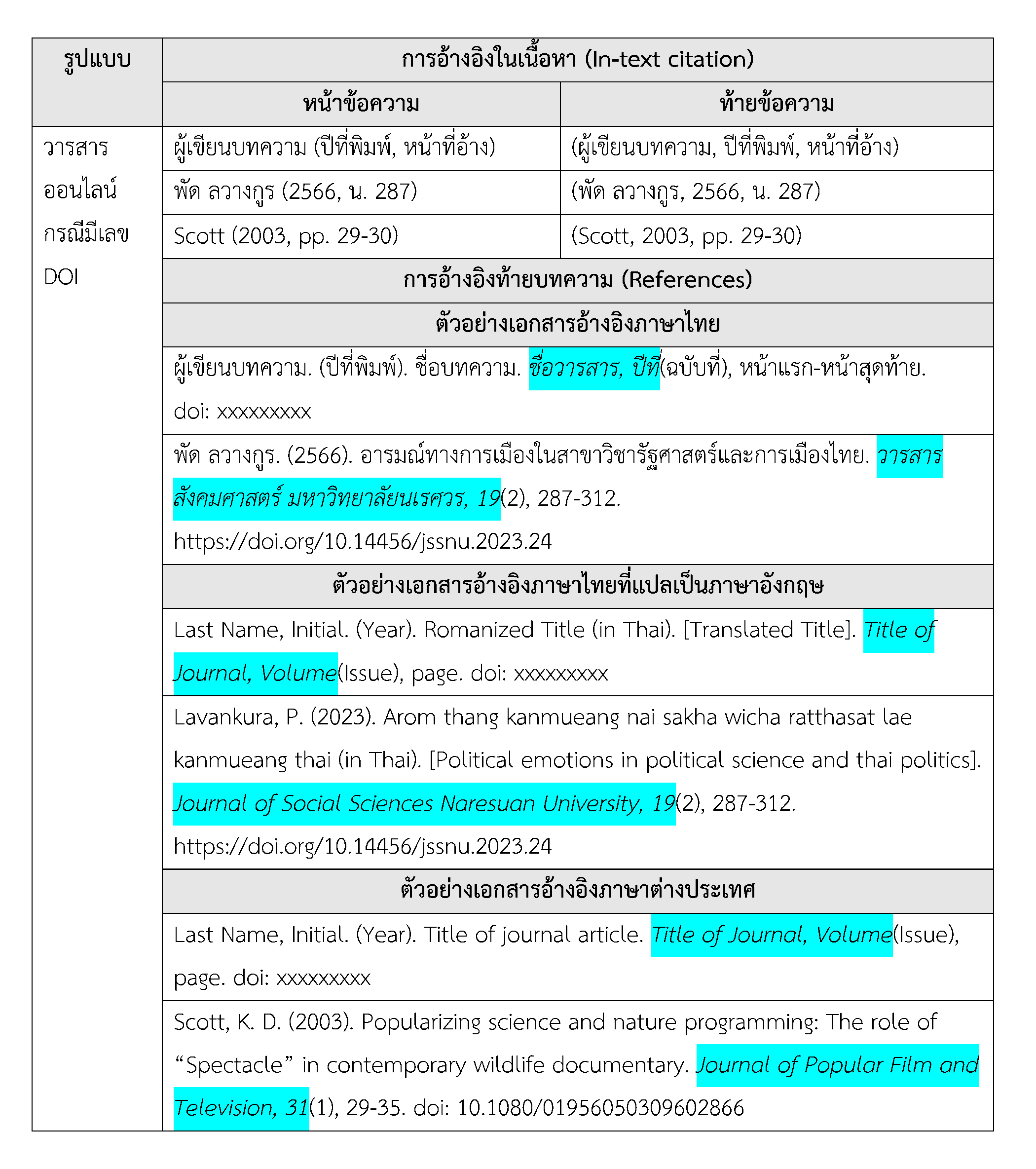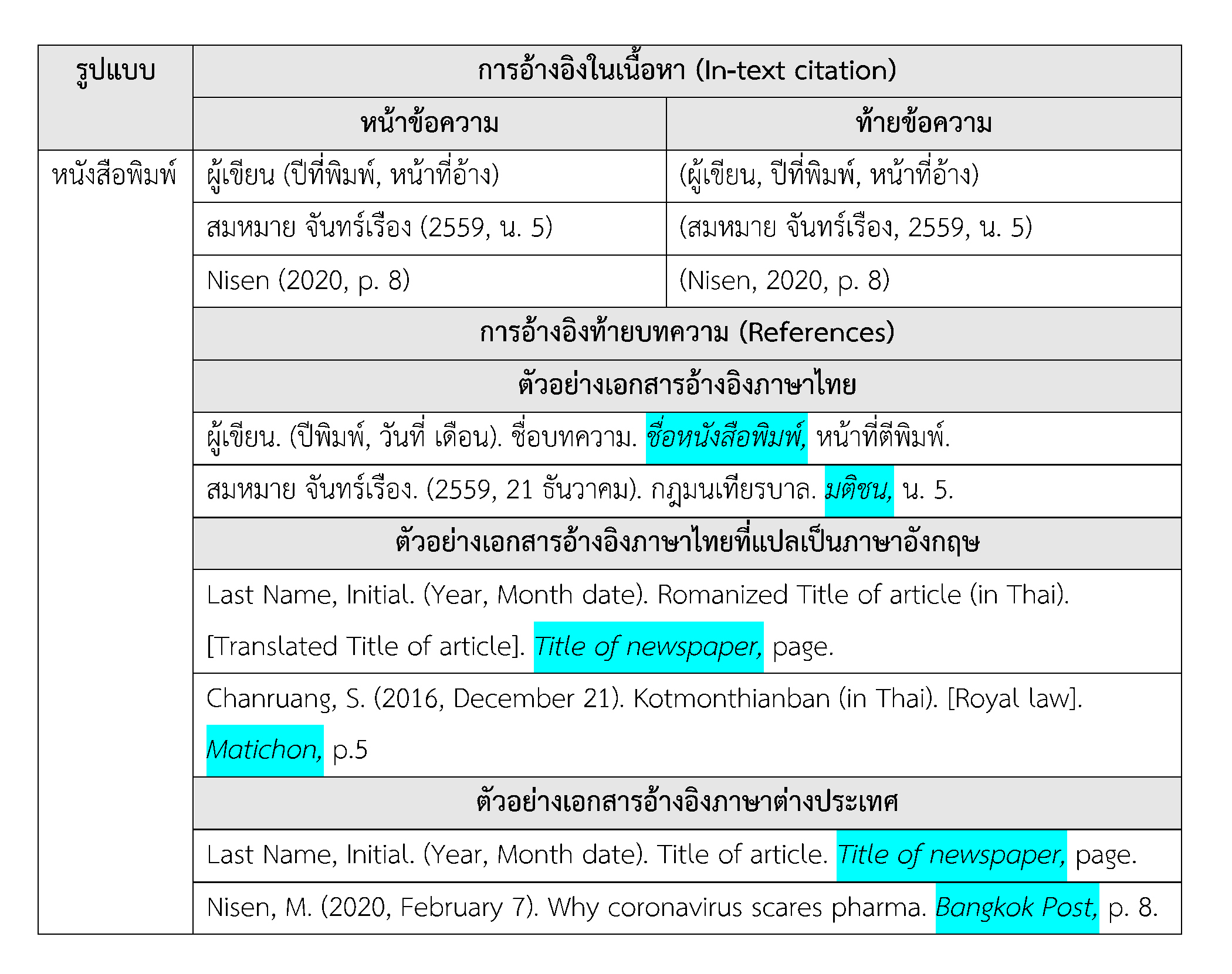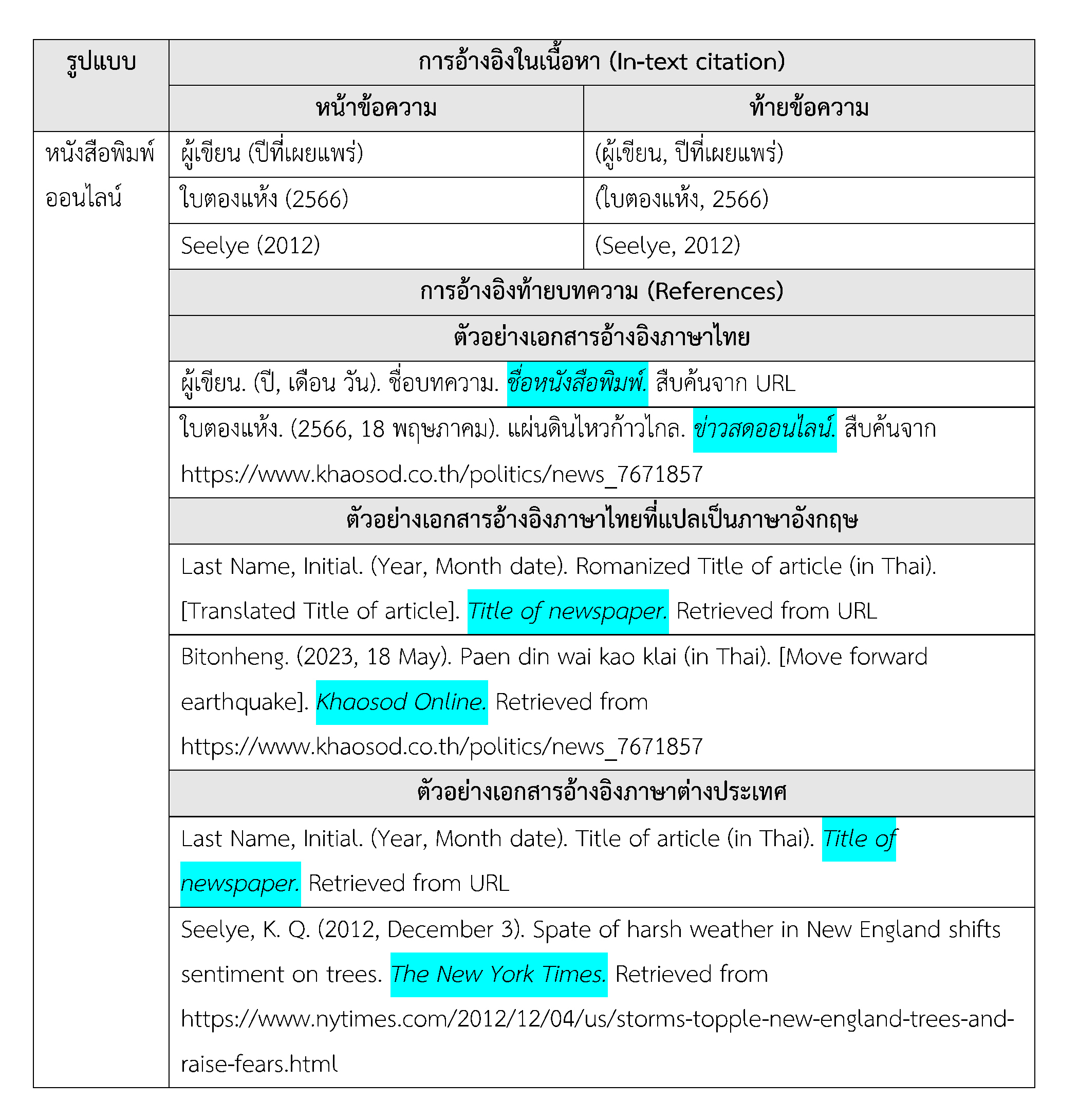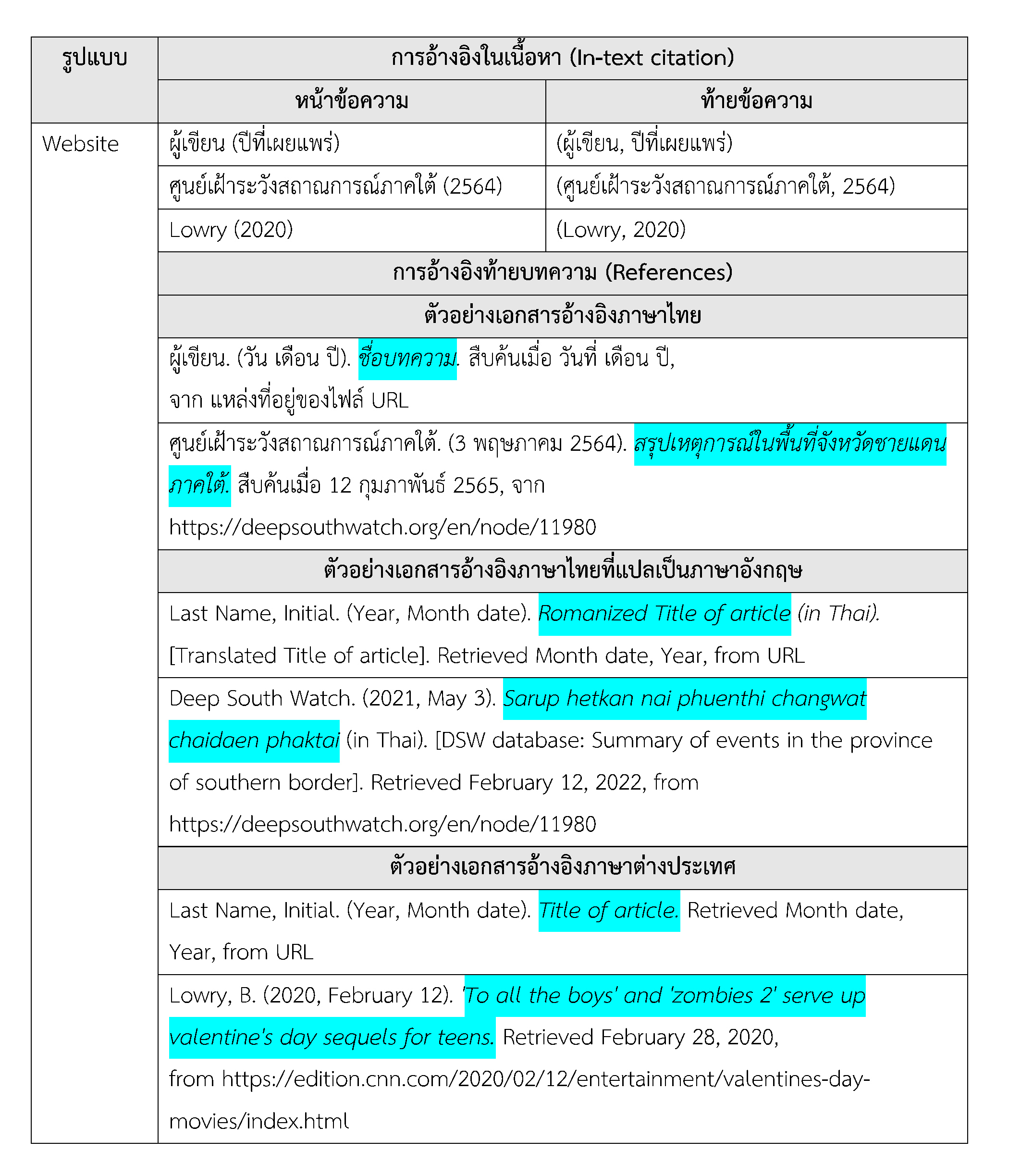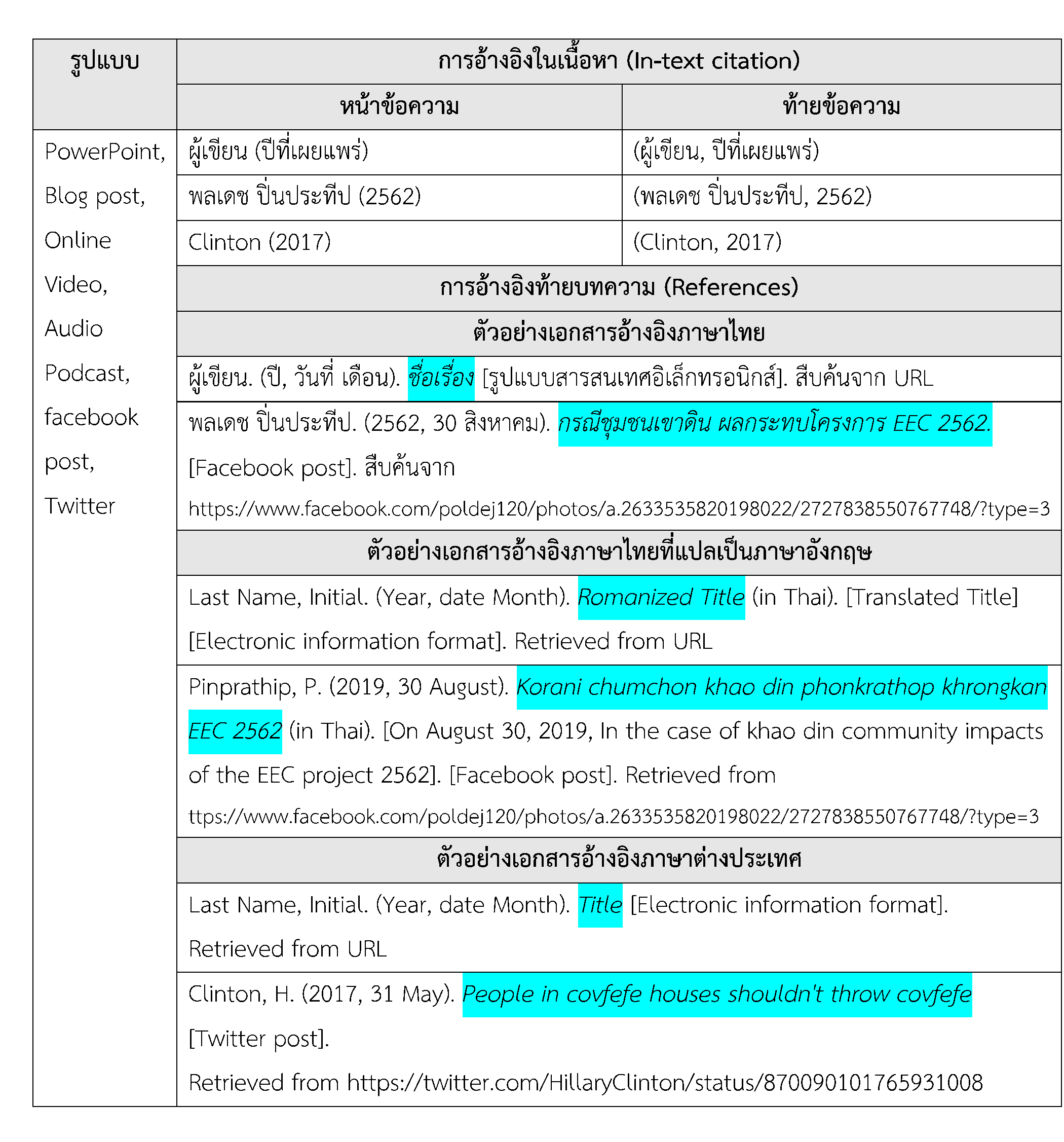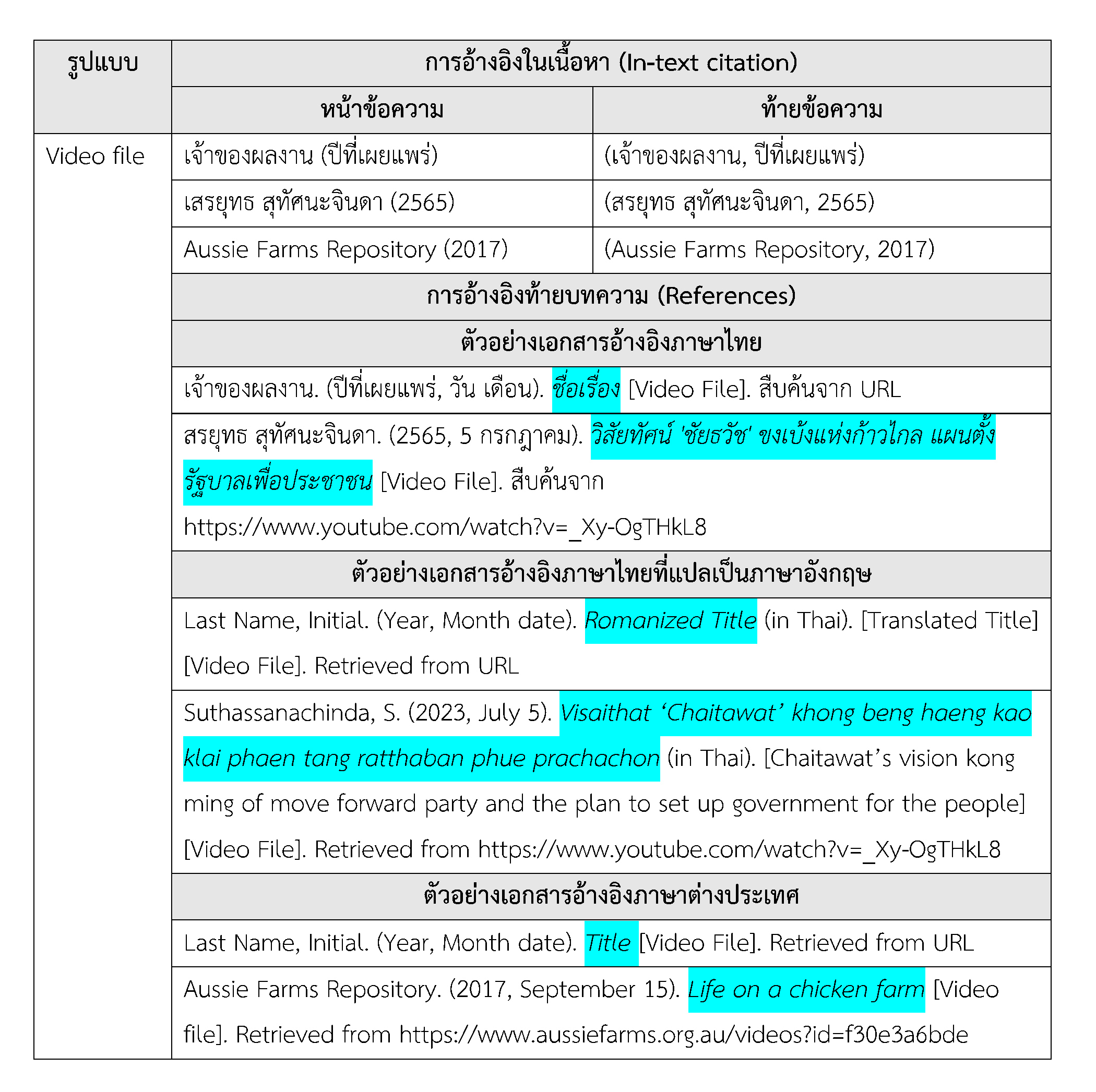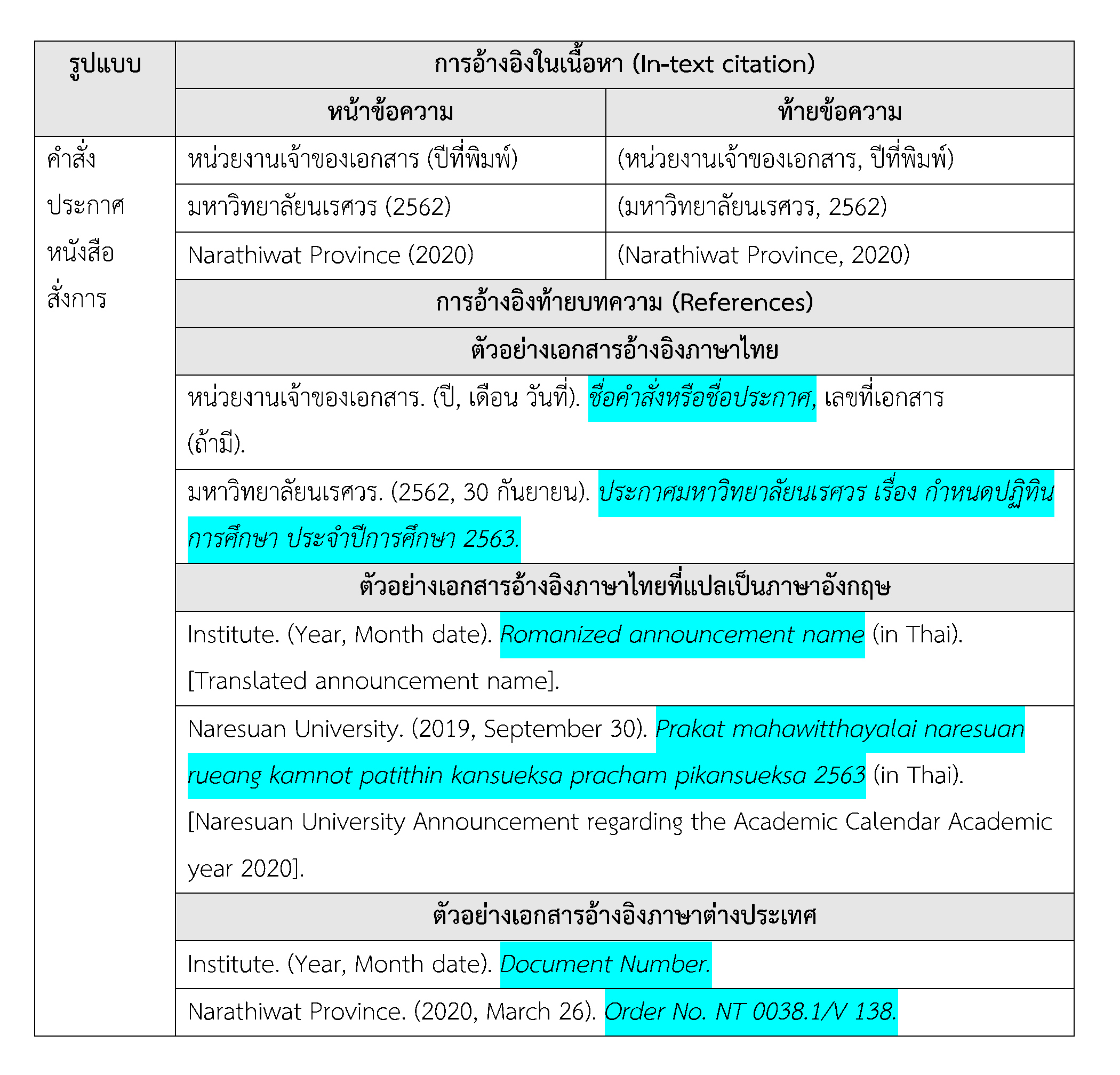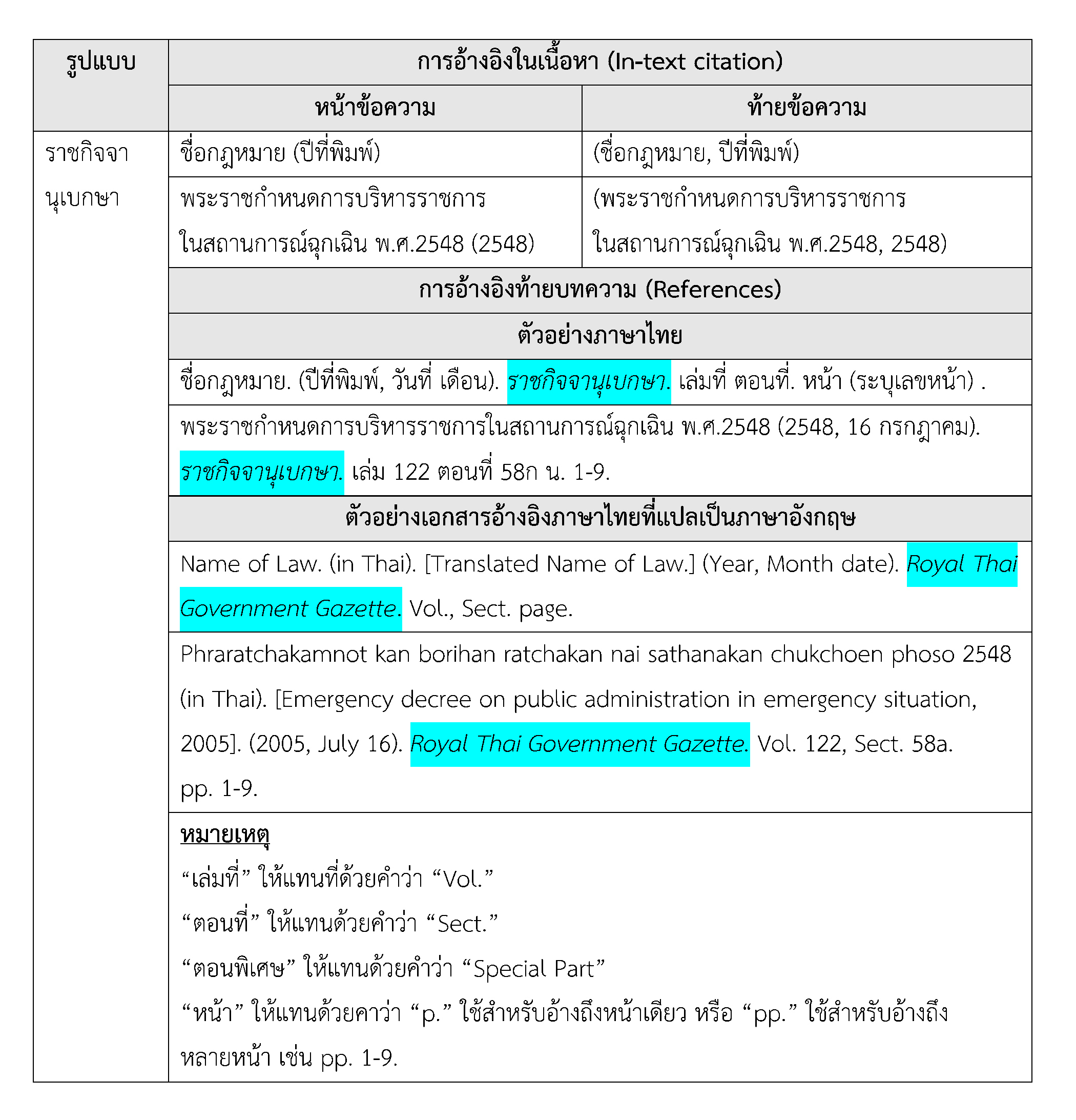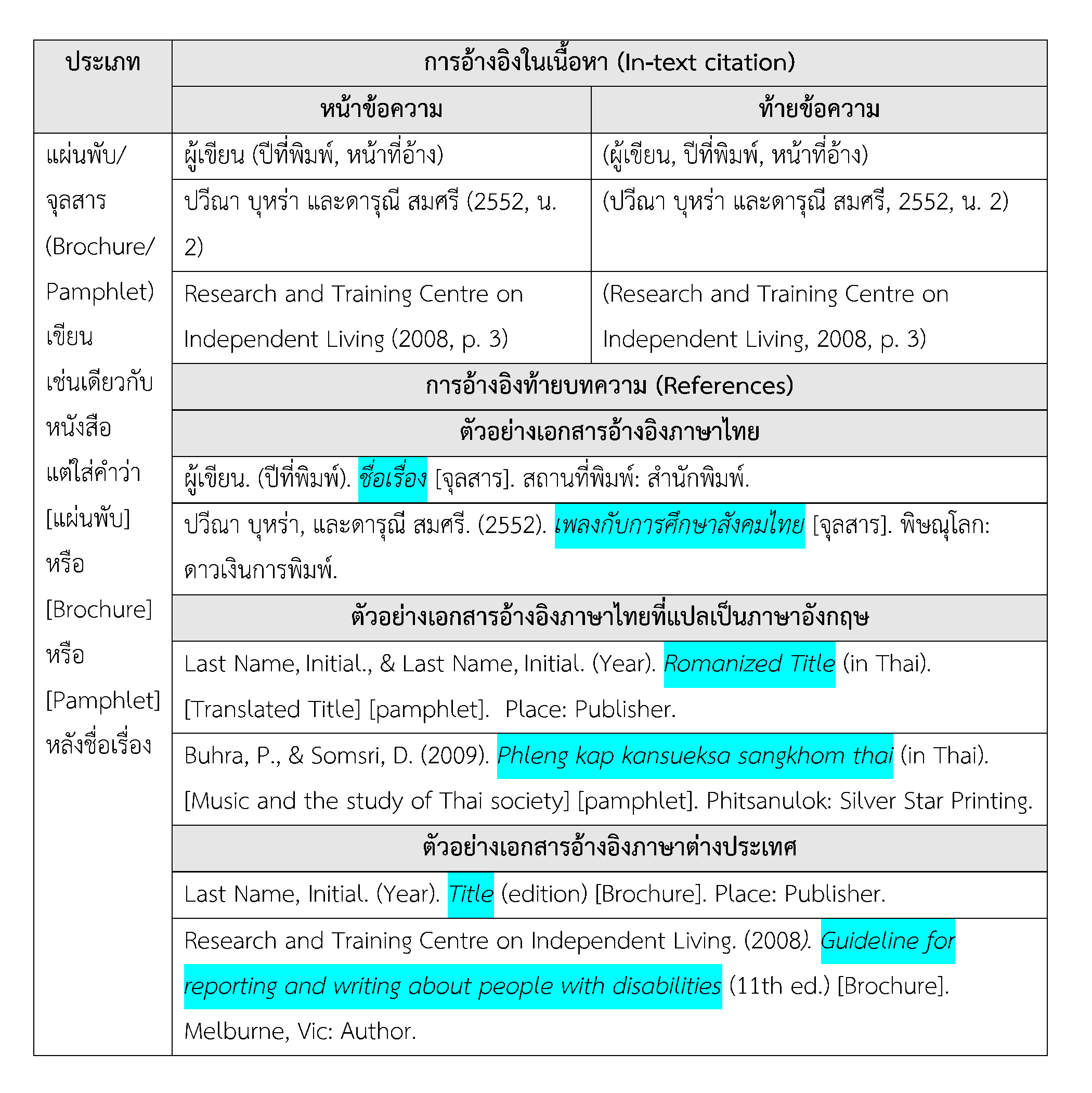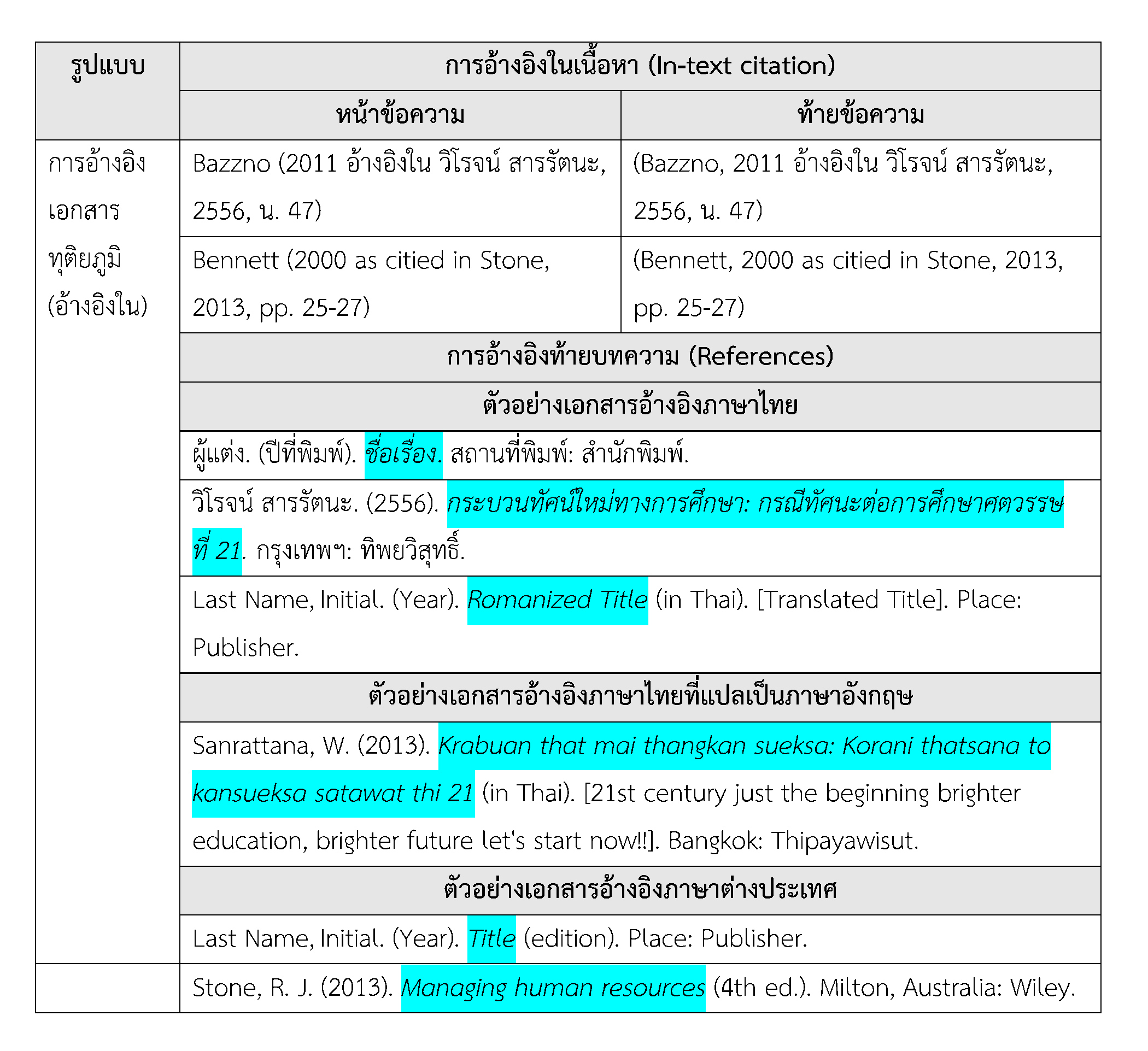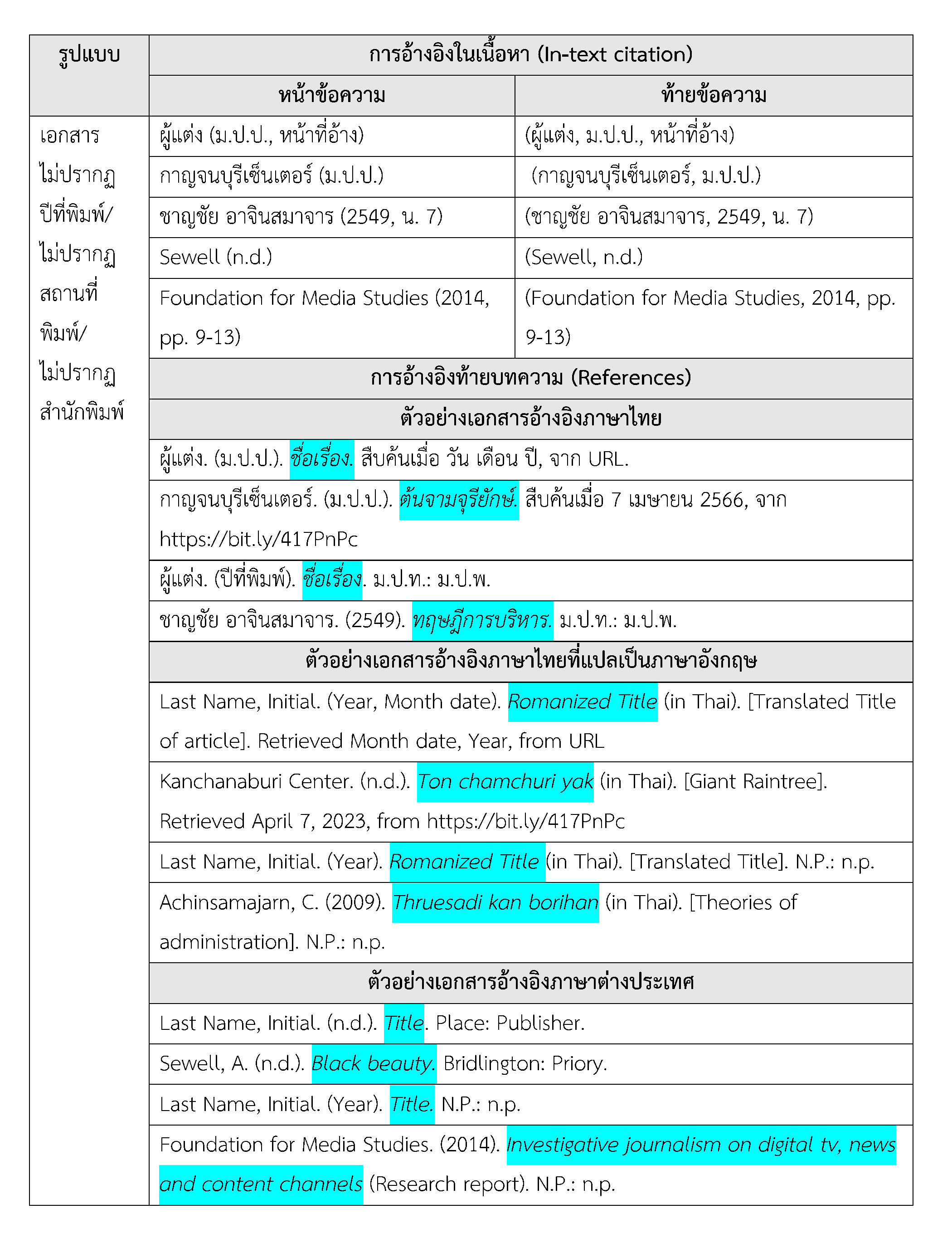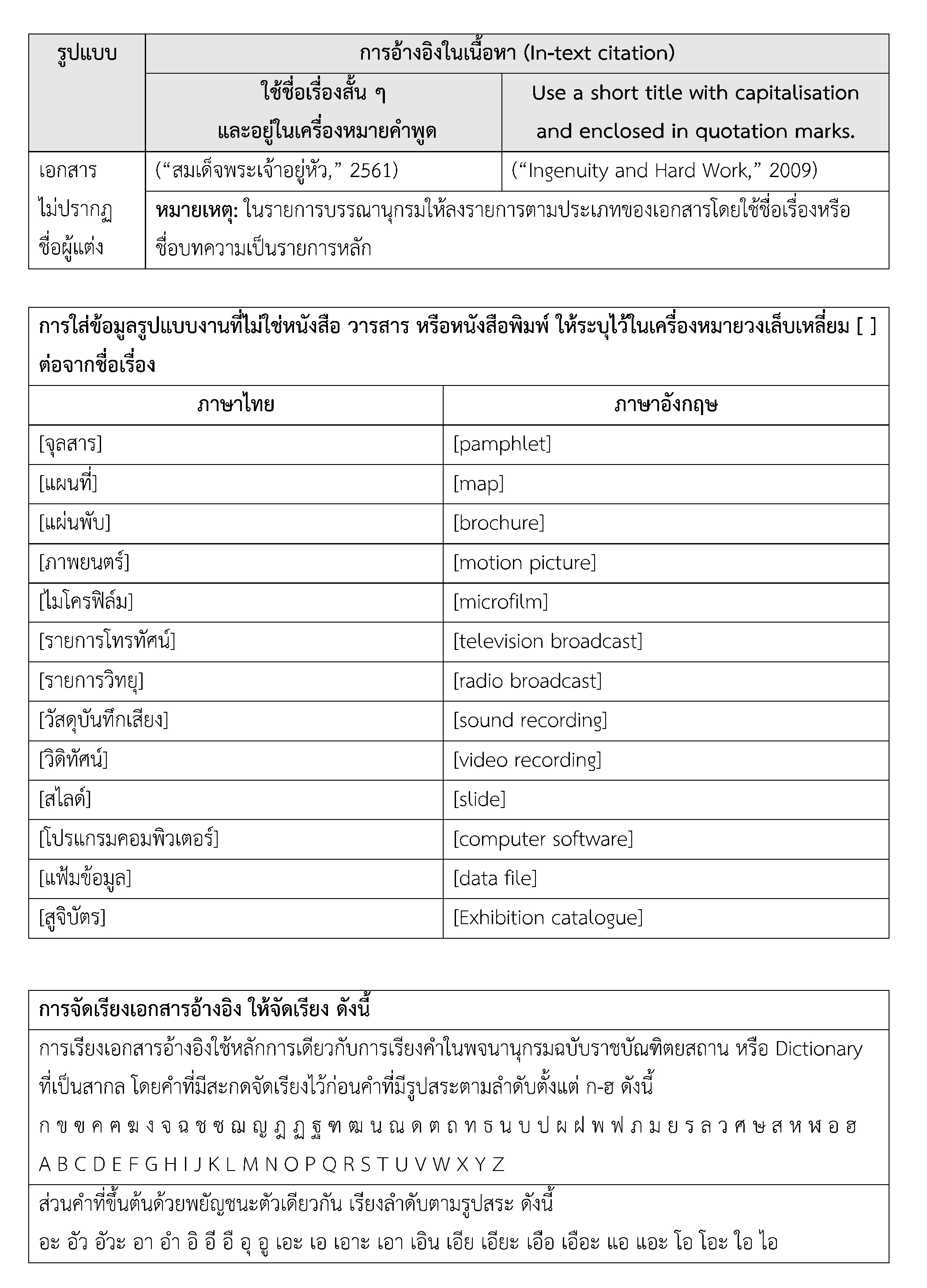Referencing Style Guide
ดาวน์โหลด : รูปแบบการอ้างอิง [PDF]
รูปแบบการอ้างอิง
วารสารสังคมศาสตร์ มหาวิทยาลัยนเรศวร ใช้ระบบการอ้างอิงและบรรณานุกรมของ APA (American Psychology Association) ฉบับพิมพ์ครั้งที่6 โดยแบ่งรูปแบบการอ้างอิงออกเป็น 2 ประเภท ดังนี้
- การอ้างอิงในเนื้อหา (In-text citation) เพื่อบอกแหล่งที่มาของข้อความนั้น ให้ใช้วิธีการอ้างอิงแบบนาม-ปี (author-date citation system) โดยระบุผู้แต่ง ปีพิมพ์ และเลขหน้าของเอกสาร ไว้ด้านหน้าหรือด้านหลังของข้อความที่ต้องการอ้างอิง ทั้งนี้ ให้ใช้เครื่องหมายจุลภาคคั่น ( , ) รูปแบบ การอ้างอิงแทรกในเนื้อหามี ดังนี้
- 1.1 เอกสารภาษาไทยให้ระบุชื่อ นามสกุลของผู้แต่ง ส่วนเอกสารภาษาต่างประเทศให้ระบุนามสกุลของผู้แต่งเท่านั้น
- 1.2 ผู้แต่ง 2 คน ให้ใช้คำเชื่อม “และ” ระหว่างชื่อผู้แต่งสำหรับเอกสารภาษาไทย ส่วนเอกสารภาษาต่างประเทศให้ใช้คำเชื่อม “and” หรือ เครื่องหมาย “&”
- 1.3 ผู้แต่ง 3 คน ให้ใช้เครื่องหมายจุลภาคคั่น (,) ระหว่างชื่อผู้แต่งสองคนแรก และใช้คำว่า “และ” คั่นระหว่างผู้แต่งคนที่ 2 กับคนที่ 3 ในเอกสารภาษาไทย สำหรับเอกสารภาษาต่างประเทศ ให้ใช้ เครื่องหมาย “&”คั่นระหว่างผู้แต่งคนที่สองกับคนที่ 3
- 1.4 ผู้แต่งมากกว่า 3 คน ให้ใส่ชื่อผู้แต่งคนแรก ตามด้วยคำว่า “และคณะ” ในเอกสารภาษาไทย หรือ “et al.” ในเอกสารภาษาต่างประเทศ
- 1.5 ปีที่พิมพ์ เอกสารภาษาไทย ให้ระบุ ปี พ.ศ. สำหรับเอกสารภาษาต่างประเทศให้ระบุ ปี ค.ศ. ทั้งนี้ ให้ระบุเพียงตัวเลข และใช้ปีพิมพ์ครั้งล่าสุด
- 1.6 หน้าที่อ้าง เอกสารภาษาไทยให้ใช้คำว่า “น.” สำหรับเอกสารภาษาต่างประเทศ ให้แทนคำว่า “หน้า” ด้วย p. ในการอ้างเอกสารหน้าเดียว และ pp. ในการอ้างเอกสารมากกว่าหนึ่งหน้า
- 1.7 การอ้างเอกสารมากกว่า 1 เรื่อง ที่มีผู้แต่งต่างกัน ให้เรียงลำดับอักษรชื่อผู้แต่งคั่นด้วยเครื่องหมายอัฒภาค (;) กรณีที่งานทั้งภาษาไทยและภาษาต่างประเทศถูกอ้างพร้อมกัน ให้เริ่มที่งานเขียนภาษาไทยก่อน เช่น วุฒิกรณ์ ชูวัฒนานุรักษ์, 2561; Carson, 2016
- 1.8 ในการอ้างเอกสารอ้างอิงแทรกในเนื้อหาโดยที่ไม่ใช้เอกสารต้นฉบับ ให้ระบุชื่อเอกสารต้นฉบับและคำว่า “อ้างอิงใน” สำหรับเอกสารภาษาไทย หรือ “as cited in” สำหรับเอกสารภาษาต่างประเทศ
- 1.9 รูปแบบการใช้ภาษาอังกฤษในเนื้อเรื่องภาษาไทย
- 1.9.1 ชื่อเฉพาะให้ขึ้นต้นด้วยตัวใหญ่ทุกคำ เช่น Berdmann, Lemmermann
- 1.9.2 ภาษาอังกฤษทั้งในและนอกวงเล็บให้ใช้ตัวเล็ก เช่น สื่อและเทคโนโลยีดิจิทัลจึงมาพร้อมกับการเข้าถึง (access) การใช้ (use) การนำมาปฏิบัติ (implementation)
- 1.9.3 ตัวย่อให้ใช้อักษรตัวใหญ่ทั้งหมด และควรมีคำเต็มบอกไว้ในการใช้ครั้งแรก เช่น (High Density Polyethylene: HDPE)
- การอ้างอิงท้ายบทความ (References)
- 2.1 ผู้แต่ง 2 คน ให้ใช้เครื่องหมายจุลภาคคั่น ( , ) ระหว่างชื่อผู้แต่ง และใช้คำเชื่อม “และ” ระหว่างชื่อผู้แต่งเอกสารที่เป็นภาษาไทย ส่วนเอกสารที่เป็นภาษาต่างประเทศให้ใช้เครื่องหมายจุลภาคคั่น ( , ) ระหว่างชื่อผู้แต่ง และใช้เครื่องหมาย “&” เชื่อมระหว่างชื่อผู้แต่ง
- 2.2 ผู้แต่ง 3 คน ให้ใช้เครื่องหมายจุลภาคคั่น (,) ระหว่างชื่อผู้แต่งสองคนแรก และใช้คำว่า “และ” คั่นระหว่างผู้แต่งคนที่ 2 กับคนที่ 3 ในเอกสารภาษาไทย สำหรับเอกสารภาษาต่างประเทศ ให้ใช้ เครื่องหมาย “&”คั่นระหว่างผู้แต่งคนที่สองกับคนที่ 3
- 2.3 ผู้แต่ง 3-7 คน ให้ใส่ชื่อผู้แต่งทุกคน โดยใช้เครื่องหมายจุลภาคคั่น ( , ) และเชื่อมด้วย คำว่า “และ” ตามด้วยชื่อผู้แต่งคนสุดท้ายในเอกสารภาษาไทย ส่วนเอกสารภาษาต่างประเทศให้เชื่อมด้วยเครื่องหมาย “&” ตามด้วยชื่อผู้แต่งคนสุดท้าย
- 2.4 ผู้แต่ง 8 คนขึ้นไป ให้ใส่ชื่อผู้แต่งคนที่ 1-6 โดยใช้เครื่องหมายจุลภาคคั่น ( , ) ตามด้วย ผู้แต่งคนสุดท้าย
- 2.5 เอกสารอ้างอิง แบ่งเป็น 3 ประเภท และเรียงลำดับ ดังนี้
- 2.5.1 เอกสารอ้างอิงภาษาไทย
- 2.5.2 เอกสารอ้างอิงภาษาไทยที่แปลเป็นภาษาอังกฤษ ใช้ตามหลักเกณฑ์การลงรายการเพื่อเข้าสู่มาตรฐาน Asian Citation Index-ACI โดย ชื่อเรื่อง (Title) จะต้องทำให้เป็น Thai Romanization (การถอดอักษรไทยเป็นอักษรโรมัน) และต้องแปลเป็นภาษาอังกฤษในวงเล็บเหลี่ยม […] สำหรับการทำ Romanization แนะนำให้ใช้โปรแกรม Thai Romanization ในการแปลง และยึดตามหลักเกณฑ์ของคณะอักษรศาสตร์ จุฬาลงกรณ์มหาวิทยาลัย สามารถสืบค้นจาก https://www.arts.chula.ac.th/~ling/tts/principles_eng.pdf
- 2.5.3 เอกสารอ้างอิงภาษาต่างประเทศ
- 2.5.4 การเรียงลำดับเอกสารอ้างอิง ให้จัดเรียง ดังนี้ 1) เอกสารอ้างอิงภาษาไทย (ทางวารสารจะใช้ในการตรวจสอบการแปลเท่านั้น) 2) เอกสารอ้างอิงภาษาไทยที่แปลเป็นภาษาอังกฤษ ให้จัดเรียงคู่กับเอกสารอ้างอิงภาษาไทย 3) เอกสารอ้างอิงภาษาต่างประเทศ
- 2.6 เอกสารอ้างอิงที่มีชื่อผู้แต่งคนเดียวกัน และจัดพิมพ์ปีเดียวกัน ในเอกสารอ้างอิงภาษาไทย ให้ใช้อักษร ก ข ค ง...กำกับหลังปีที่พิมพ์ ส่วนเอกสารอ้างอิงภาษาต่างประเทศ ให้ใช้อักษร a b c d...กำกับหลังปีที่พิมพ์
- 2.7 ชื่อบทความในบรรณานุกรมภาษาต่างประเทศ ให้ใช้ตัวอักษรตัวแรกเป็นตัวพิมพ์ใหญ่เท่านั้น นอกนั้นให้ใช้เป็นตัวอักษรตัวพิมพ์เล็ก ยกเว้น ตัวแรกที่ตามหลังสัญลักษณ์ : หรือ ; หรือคำเฉพาะ เช่น ชื่อคน หรือชื่อประเทศ
- 2.8 ชื่อบทความหรือชื่อเรื่องที่ใช้ในการอ้างอิงให้ทำเป็นตัวเอน
- 2.9 การลงรายการครั้งที่พิมพ์ให้ลงรายการตั้งแต่การพิมพ์ครั้งที่ 2
- 2.10 เอกสารไม่ปรากฏปีที่พิมพ์ ให้ใช้อักษรย่อ ม.ป.ป. ซึ่งย่อมาจากคำว่าไม่ปรากฏปีที่พิมพ์สำหรับเอกสารภาษาไทย และใช้คำว่า n.d. ซึ่งย่อมาจากคำว่า no date สำหรับเอกสารภาษาต่างประเทศ
- 2.11 เอกสารไม่ปรากฏสถานที่พิมพ์ ให้ใช้อักษรย่อ ม.ป.ท. ซึ่งย่อมาจากคำว่าไม่ปรากฏสถานที่พิมพ์สำหรับเอกสารภาษาไทย และใช้คำว่า N.P. ซึ่งย่อมาจากคำว่า No Place สำหรับเอกสารภาษาต่างประเทศ
- 2.12 เอกสารไม่ปรากฏสำนักพิมพ์ ให้ใช้อักษรย่อ ม.ป.พ. ซึ่งย่อมาจากคำว่าไม่ปรากฏสำนักพิมพ์สำหรับเอกสารภาษาไทย และใช้คำว่า n.p. ซึ่งย่อมาจากคำว่า no publisher สำหรับเอกสารภาษาต่างประเทศ
- 2.13 เอกสารที่มีบรรณาธิการ (Editor) หรือผู้รวบรวม (Compiler) ให้ลงชื่อบรรณาธิการหรือผู้รวบรวมในตำแหน่งของผู้แต่ง ตามด้วยวงเล็บคำว่าบรรณาธิการ หรือผู้รวบรวม หรือ Ed. หรือ Comp. ในกรณีเอกสารภาษาต่างประเทศ ที่มีบรรณาธิการหลายคน ให้ใช้คำว่า Eds.
- การอ้างอิงแบบเชิงอรรถ (Footnote citation) ให้ใช้เฉพาะเชิงอรรถขยายความเท่านั้น โดยการอ้างอิงแทรกในเนื้อหา เป็นส่วนช่วยเพิ่มเติม หรือขยายความของข้อมูลโดยการบอกแหล่งที่มา ไม่ควรซับซ้อน ควรเขียนเป็นประโยคสั้น ๆ กะทัดรัดและเข้าใจง่าย ซึ่งหากมีความยาวมากเกินไป ควรนำไปอ้างอิงแทรกในเนื้อหา
- บทความภาษาไทย เมื่อได้รับการตอบรับให้ตีพิมพ์แล้ว ผู้เขียนจะต้องดำเนินการแปลเอกสารอ้างอิงในเนื้อหา (In-text citation) เป็นภาษาอังกฤษให้ถูกต้องตรงกัน เพื่อให้เป็นไปตามแบบมาตรฐานสากล ทั้งนี้ มีข้อกำหนด ดังนี้
- 4.1 กรณีอ้างอิงผู้แต่งชาวไทย ให้เขียนชื่อ นามสกุล ไว้นอกวงเล็บ และแปลนามสกุลของผู้แต่งเป็นภาษาอังกฤษไว้ในวงเล็บ เช่น อัจฉรา อัศวรุจิกุลชัย, พิมลพรรณ หาญศึก และเพียงใจ พีระเกียรติขจร (Ussawarujikulchai, Hansuk, & Peerakiatkhajohn, 2011, p. 17)
- 4.2 กรณีผู้แต่งชาวต่างชาติ ให้ใส่นามสกุลของผู้แต่งไว้ในวงเล็บ เช่น (Sparviero & Ragnedda, 2021)
